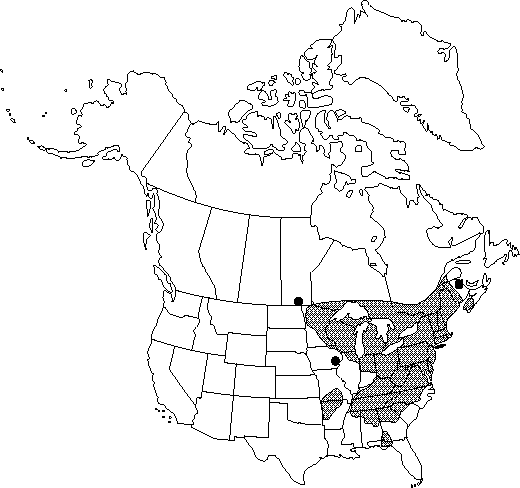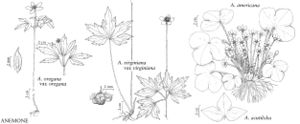FNA>Volume Importer |
FNA>Volume Importer |
| Line 36: |
Line 36: |
| | }}<!-- | | }}<!-- |
| | | | |
| − | --><span class="statement" id="st-d0_s0" data-properties="shoot location;shoot some measurement;rhizome orientation;rhizome orientation;rhizome orientation"><b>Aerial </b>shoots 5-18 cm, from rhizomes, rhizomes ascending to horizontal.</span> <span class="statement" id="st-d0_s1" data-properties="basal leaf quantity;basal leaf coloration;basal leaf architecture;basal leaf shape"><b>Basal </b>leaves 3-15, often purplish abaxially, simple, deeply divided;</span> <span class="statement" id="st-d0_s2" data-properties="petiole some measurement">petiole 5-20 cm;</span> <span class="statement" id="st-d0_s3" data-properties="leaf-blade shape;leaf-blade length;leaf-blade width;base shape;margin architecture or shape;apex shape;surface pubescence;surface pubescence;surface pubescence">leaf-blade widely orbiculate, 1.5-7 × 2-10 cm, base cordate, margins entire, apex rounded, surfaces strongly villous to glabrescent;</span> <span class="statement" id="st-d0_s4" data-properties="lobe atypical quantity;lobe quantity;lobe shape;lobe width">lobes 3 (-4), widely ovate, 1-4 cm wide;</span> <span class="statement" id="st-d0_s5" data-properties="">middle lobe 50-70 (-75) % of total blade length.</span> <span class="statement" id="st-d0_s6" data-properties="inflorescence architecture;inflorescence pubescence;inflorescence pubescence;inflorescence pubescence"><b>Inflorescences </b>1-flowered, villous to pilose;</span> <span class="statement" id="st-d0_s7" data-properties="involucral-beak quantity;involucral-beak arrangement;involucral-beak architecture;involucral-beak architecture;involucral-beak architecture or shape;involucral-beak shape;involucral-beak shape;involucral-beak length;involucral-beak width;base fusion;base shape;margin architecture or shape;apex shape;apex pubescence;apex pubescence;apex pubescence">involucral-bracts 3, 1-tiered, simple, dissimilar to basal leaves, sessile, calyxlike, closely subtending flower, ovate or elliptic, 0.65-1.8 × 0.5-1.2 cm, bases distinct, cuneate, margins entire, apex obtuse, strongly villous to glabrescent.</span> <span class="statement" id="st-d0_s8" data-properties="sepal quantity;sepal coloration;sepal coloration;sepal coloration;sepal coloration;sepal shape;sepal shape;sepal shape;sepal length;sepal width;sepal pubescence"><b>Flowers:</b> sepals 5-12, white to pink or bluish, ovate to obovate 7.5-14.5 × 3.5-7.7 mm, glabrous;</span> <span class="statement" id="st-d0_s9" data-properties="petal presence">petals absent;</span> <span class="statement" id="st-d0_s10" data-properties="stamen quantity">stamens 10-30.</span> <span class="statement" id="st-d0_s11" data-properties="head shape"><b>Heads </b>of achenes spheric;</span> <span class="statement" id="st-d0_s12" data-properties="pedicel some measurement">pedicel 0.1-0.4 cm.</span> <span class="statement" id="st-d0_s13" data-properties="body shape;body length;body width;body architecture;body pubescence;body shape"><b>Achenes:</b> body narrowly ovoid, 3.5-5 × 1.2-1.6 mm, slightly winged, hispid, gradually tapering;</span> <span class="statement" id="st-d0_s14" data-properties="">beak indistinct.</span> <span class="statement" id="st-d0_s15" data-properties="beak prominence;2n chromosome quantity">2n=14.</span><!-- | + | --><span class="statement" id="st-undefined" data-properties=""><b>Aerial </b>shoots 5-18 cm, from rhizomes, rhizomes ascending to horizontal. <b>Basal</b> leaves 3-15, often purplish abaxially, simple, deeply divided; petiole 5-20 cm; leaf blade widely orbiculate, 1.5-7 × 2-10 cm, base cordate, margins entire, apex rounded, surfaces strongly villous to glabrescent; lobes 3(-4), widely ovate, 1-4 cm wide; middle lobe 50-70(-75)% of total blade length. <b>Inflorescences</b> 1-flowered, villous to pilose; involucral bracts 3, 1-tiered, simple, dissimilar to basal leaves, sessile, calyx-like, closely subtending flower, ovate or elliptic, 0.65-1.8 × 0.5-1.2 cm, bases distinct, cuneate, margins entire, apex obtuse, strongly villous to glabrescent. <b>Flowers</b>: sepals 5-12, white to pink or bluish, ovate to obovate 7.5-14.5 × 3.5-7.7 mm, glabrous; petals absent; stamens 10-30. <b>Heads</b> of achenes spheric; pedicel 0.1-0.4 cm. <b>Achenes</b>: body narrowly ovoid, 3.5-5 × 1.2-1.6 mm, slightly winged, hispid, gradually tapering; beak indistinct. <b>2n</b>=14.</span><!-- |
| | | | |
| | -->{{Treatment/Body | | -->{{Treatment/Body |
| Line 67: |
Line 67: |
| | |publication year=1958 | | |publication year=1958 |
| | |special status=Endemic;Selected by author to be illustrated | | |special status=Endemic;Selected by author to be illustrated |
| − | |source xml=https://jpend@bitbucket.org/aafc-mbb/fna-fine-grained-xml.git/src/287ef3db526bd807d435a3c7423ef2df1e951227/V3/V3_798.xml | + | |source xml=https://jpend@bitbucket.org/aafc-mbb/fna-data-curation.git/src/9216fc802291cd3df363fd52122300479582ede7/coarse_grained_fna_xml/V3/V3_798.xml |
| | |genus=Anemone | | |genus=Anemone |
| | |species=Anemone americana | | |species=Anemone americana |
| − | |2n chromosome quantity=14
| |
| − | |apex pubescence=strongly villous;glabrescent
| |
| − | |apex shape=obtuse;rounded
| |
| − | |basal leaf architecture=simple
| |
| − | |basal leaf coloration=purplish
| |
| − | |basal leaf quantity=3;15
| |
| − | |basal leaf shape=divided
| |
| − | |base fusion=distinct
| |
| − | |base shape=cuneate;cordate
| |
| − | |beak prominence=indistinct
| |
| − | |body architecture=winged
| |
| − | |body length=3.5mm;5mm
| |
| − | |body pubescence=hispid
| |
| − | |body shape=tapering;ovoid
| |
| − | |body width=1.2mm;1.6mm
| |
| − | |head shape=spheric
| |
| − | |inflorescence architecture=1-flowered
| |
| − | |inflorescence pubescence=villous;pilose
| |
| − | |involucral-beak architecture=sessile;simple
| |
| − | |involucral-beak architecture or shape=calyxlike
| |
| − | |involucral-beak arrangement=1-tiered
| |
| − | |involucral-beak length=0.65cm;1.8cm
| |
| − | |involucral-beak quantity=3
| |
| − | |involucral-beak shape=elliptic;ovate
| |
| − | |involucral-beak width=0.5cm;1.2cm
| |
| − | |leaf-blade length=1.5cm;7cm
| |
| − | |leaf-blade shape=orbiculate
| |
| − | |leaf-blade width=2cm;10cm
| |
| − | |lobe atypical quantity=3;4
| |
| − | |lobe quantity=3
| |
| − | |lobe shape=ovate
| |
| − | |lobe width=1cm;4cm
| |
| − | |margin architecture or shape=entire;entire
| |
| − | |pedicel some measurement=0.1cm;0.4cm
| |
| − | |petal presence=absent
| |
| − | |petiole some measurement=5cm;20cm
| |
| − | |rhizome orientation=ascending;horizontal
| |
| − | |sepal coloration=white;pink or bluish
| |
| − | |sepal length=7.5mm;14.5mm
| |
| − | |sepal pubescence=glabrous
| |
| − | |sepal quantity=5;12
| |
| − | |sepal shape=ovate;obovate
| |
| − | |sepal width=3.5mm;7.7mm
| |
| − | |shoot location=aerial
| |
| − | |shoot some measurement=5cm;18cm
| |
| − | |stamen quantity=10;30
| |
| − | |surface pubescence=strongly villous;glabrescent
| |
| | }}<!-- | | }}<!-- |
| | | | |
| | -->[[Category:Treatment]][[Category:Anemone]] | | -->[[Category:Treatment]][[Category:Anemone]] |
Aerial shoots 5-18 cm, from rhizomes, rhizomes ascending to horizontal. Basal leaves 3-15, often purplish abaxially, simple, deeply divided; petiole 5-20 cm; leaf blade widely orbiculate, 1.5-7 × 2-10 cm, base cordate, margins entire, apex rounded, surfaces strongly villous to glabrescent; lobes 3(-4), widely ovate, 1-4 cm wide; middle lobe 50-70(-75)% of total blade length. Inflorescences 1-flowered, villous to pilose; involucral bracts 3, 1-tiered, simple, dissimilar to basal leaves, sessile, calyx-like, closely subtending flower, ovate or elliptic, 0.65-1.8 × 0.5-1.2 cm, bases distinct, cuneate, margins entire, apex obtuse, strongly villous to glabrescent. Flowers: sepals 5-12, white to pink or bluish, ovate to obovate 7.5-14.5 × 3.5-7.7 mm, glabrous; petals absent; stamens 10-30. Heads of achenes spheric; pedicel 0.1-0.4 cm. Achenes: body narrowly ovoid, 3.5-5 × 1.2-1.6 mm, slightly winged, hispid, gradually tapering; beak indistinct. 2n=14.
Phenology: Flowering spring.
Habitat: Mixed woods, often in association with both conifers and deciduous trees
Elevation: 0-1200 m
Distribution
Man., N.B., N.S., Ont., Que., Ala., Ark., Conn., Del., D.C., Fla., Ga., Ill., Ind., Iowa, Ky., Maine, Md., Mass., Mich., Minn., Miss., Mo., N.H., N.J., N.Y., N.C., Ohio, Pa., R.I., S.C., Tenn., Vt., Va., W.Va., Wis.
Discussion
Anemone americana is found in habitats similar to those of A. acutiloba but usually in drier sites with more acid soils.
Selected References
None.

